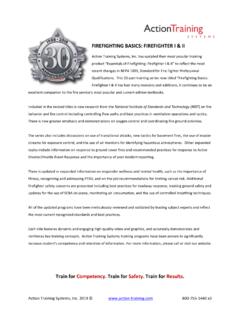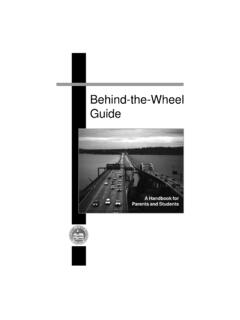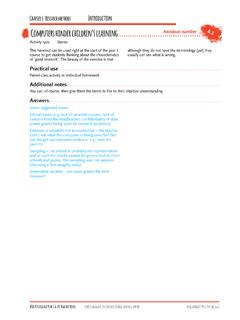Transcription of Lesson Closure 50 Ways to Leave a Lesson - .NET Framework
1 Page 1 of 10 Lesson Closure 50 ways to Leave a Lesson Closure - what the instructor does to facilitate wrap-up at the end of the Lesson - it is a quick review, to remind students what it was that they have learned (or should have learned) and allows you to see where the students are to assist you in planning for the next Lesson . The intellectual work should be done by the students not the instructor summarizing for the students and telling them what they learned. Closure allows students to summarize main ideas, evaluate class processes, answer questions posed at the beginning of the Lesson , and link to both the past and the future, or in other words MAKE MEANING. Page 2 of 10 Closure is an opportunity for formative assessment and helps the instructor decide: 1. if additional practice is needed 2.
2 Whether you need to re-teach 3. whether you can move on to the next part of the Lesson Closure comes in the form of information from students about what they learned during the class; for example, a restatement of the instructional purpose. This information then provides a knowledge of the results for the teacher, , did you teach what you intended to teach and have the students learned what you intended to have them learn? Lesson Closing in a nutshell can be one or some combination of the purposes below. It should be a meaningful end to the Lesson . Reviewing the key points of the Lesson . Giving students opportunities to draw conclusions from the Lesson . Describing when the students can use this new information. Previewing future lessons. Demonstrating student s problem-solving process. Exhibiting student learning.
3 Creating a smooth transition from one Lesson to the next Lesson . Page 3 of 10 Lesson Closure Technique with Examples (NOTE: most of these techniques work best in group settings and benefit from the synergy of a well-functioning group) Title Synopsis/Resources 1. Cornell Notes Notes can be used in a variety of ways . Completing the summary, checking with a partner for completeness, comparing to teacher s idea of what the key ideas were. 2. Journal Entry Each day students write about 3 questions What did I learn today, this connects to what I know about, What I learned about today can help me later when (use of a journal could incorporate most of these other Closure examples) 3. Exit Pass Student must answer in writing questions or reflect in some way about the learning before being allowed to Leave the room.
4 Math example work a question from the material covered during the Lesson , use as formative assessment for the following day, sort into piles: got it/ didn t get it or minor errors / conceptual errors 4. Examples I really understood this I have a few questions before I can say I understand I don t even know where to start on .. ! I am excited : I d like to learn more ? a question I have This point is really clear One thing that squares with things I already know An idea that is still going around in my head Page 4 of 10 5. You re stuck here This is a variation of the exit pass and great for a 90-30 second gap before dismissal. Depending on time, have students discuss the day s vocabulary and then they must define one word in their own words, to you, before they go out the door.
5 If they are having difficulty, have them step to the side and listen to several other students and then try again. This should be framed in good humor, not in a punitive way. 6. 3-2-1 3 things they learned, 2 things they have a question about, 1 thing they want the instructor to know post-its, index cards, whatever 7. Whip Around Students quickly and verbally share one thing they learned in the class today. You can have them toss a ball from one to another or just have volunteers. 8. Fishbowl Student writes one question they have about the topic of this Lesson . This can be something for which they know the answer or for which they want an answer. Form an inner and outer circle. Share question with the person in front of you see if they know the answer, switch who is asking question, if time, rotate to a new partner 9.
6 Summary Paragraph What was learned today be specific with examples! 10. Explain a Procedure Write to an absent student and explain how to .. 11. Here s Students write a detailed explanation of a procedure - with an example to demonstrate their understanding of the concept. They then give their partner the un-worked example and the detailed instructions and have the partner work the example from the directions. Then they peer edit the procedures for clarity. 12. Cheat Sheet Students prepare a cheat sheet that would be useful for having during a quiz over the day s topic. Page 5 of 10 13. Three W s Students discuss or write What did we learn today? So, What? (relevancy, importance, usefulness) Now What? (how does this fit into what we are learning, does it affect our thinking, can we predict where we are going) 14.
7 Pair / Share Tell the person next to you 2 (3,4, ) things you have learned today, then the groups report out. Variation is to have students Think/Write/Pair/ Share 15. Gallery Walk Students create graphic representations of their learning and post them. Students can either share out the posters or students can move from station to station writing questions or comments, noting similarities and differences, reflect on what they might do differently if they were to repeat the process. 16. Quiz Could be daily or intermittent. 2-4 questions to show what they learned. Small individual whiteboards work well for a formative assessment and reduces the paperwork. Don t forget to ask conceptual questions! 17. Thumbs Up/ Thumbs down Pose some questions that can be answered thumbs up/down/ sideways, ask for explanation of the decisions.
8 18. Quick doodles Doodle/draw two or three concepts presented in the Lesson - -may include words or numbers. 19. Key Ideas Students list the key ideas from the Lesson and why they were important. Page 6 of 10 20. What am I? (riddles for key terms) Have students construct clues (riddles) about the key terms and quiz partners or the room 21. Jeopardy Teacher gives answer. Students create the question. This works well with dry erase boards. 22. Be Alex Trebek Student poses answer/question to group about Lesson responses should come from other students, not the teacher 23. Be the Teacher Students present three key ideas they think everyone should have learned. Could be done with a group or individually responses can be either oral or written. 24. Pros and Cons Students list pros and cons of the issue discussed in class 25.
9 So, What s Up With ..? Students raise questions about something they either were unsure about or need clarification. Can be done orally or written. 26. Quiz Master Students prepare a short quiz (+ 5 questions with answers) At least 2 of the questions must start or 27. Journal Entry Each day students write about 2 things they learned (use of a journal could incorporate most of these other Closure examples.) 28. I Care Why? Students explain relevancy of the concept to their life or how they might use it. 29. Element of Surprise Students receive an envelope containing a card with a word or phrase selected by the teacher. Students discuss the concept and list the content-specific vocabulary necessary to discuss it. Page 7 of 10 30. Numbered Heads Together Students in groups of up to five are numbered sequentially.
10 As a group they create a list of 3-5 things learned in the Lesson and then the teacher calls one number from each group to report to the class something they learned. 31. We Learned What? Students write open ended questions on index cards. Two students are selected to come forward. The first student draws a question card and poses the question to the class. After the class discusses the question and answers with their partner - the second student draws a student name card to respond to the question. (These questions could also be used to launch the next day s Lesson .) 32. We re Going Where? Students predict the topic of tomorrow s Lesson be sure to refer to the predictions the next day as either an opener or in Closure . 33. It Looks Like This An actual object or model that directly relates to the Lesson is shown and students explain how it connects to the day s concept.




